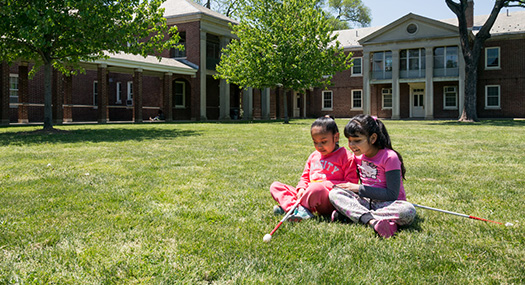Promoting Friendship Among Preschoolers Who Are Blind or Low Vision

The preschool years are all about learning to be a friend. In fact, much of the preschool curriculum is devoted to supporting the development of skills for interacting with peers. Children with blindness or low vision often need intentional help in developing the skills that can lead to strong peer relationships.
Familiarity with Toys and Materials
Much peer interaction is centered on the materials in a typical preschool classroom. Provide your child opportunities to explore these items. Children with blindness or low vision cannot see to copy the play of others. Your child may find it helpful to be shown how to play with various materials in the classroom. Talk to your preschool teacher about borrowing classroom materials overnight so your child can independently explore the items. Once your child is familiar with the materials, you can show how they might play with them in the classroom. This will help your child learn to play while also showing them how fun play can be.
Familiarity with Pretend Play
Pretend play is common in preschool classrooms. Show your child how to pretend by acting out past experiences together. To take this skill further, each preschool classroom has common pretend themes. Help your child participate by making sure your child is familiar with the scenario as well as the materials in the play set. For example, if their peers often play ice cream shop, then your child will need to understand who would be in an ice cream shop, what would happen in such a situation, and what materials would be involved. All of this can be introduced as you play with your child. Making the experience fun will encourage your child to participate.
Familiarity to Peers
Watch for children who you feel could be potential playmates for your child. A foundation for friendship could be built on a common interest, a similar temperament, or any other factor that draws children together. Setting up playdates outside of school allows for a quieter environment that might be more conducive to establishing a relationship.
Experience-Base for Play and Conversation
Children often talk about past and future experiences. They act out scenarios with which they are familiar. Providing your child with experiences common to other young children will help him have the experience base and knowledge to join in peer play.
Rules for Sharing
In a preschool community, rules for sharing are rigid. If a child does not share appropriately, this risks alienation from peers. When you play with your child, help your child follow the rules that promote relationships among preschoolers.
- Ask before taking toys from others
- Play with some, but not all, of the toys in an area
- Offer toys to others
Others-Oriented and Considerate
Create curiosity and wonder about what others are thinking and feeling. You can work toward this understanding by reading books and talking about feelings. It is typical for all children at the preschool level to begin to develop the understanding that others have different thoughts and preferences. This realization leads to empathy, consideration, and other-oriented actions. Talking about thoughts and feeling will help this understanding develop.
Scripts for Initiating Interaction and Accepting Initiation
Perhaps the hardest part of play is entering the play situation. Teach your child some techniques through modeling and practicing as you play together.
- Direct a play request to specific children by name.
- Ask to play using a phrase that does not change the play situation.
- Be positive and complimentary.
- Add ideas to play. For example, if a group is going to play construction in the block center, a child might offer an idea for how to build the tower.
- Accepting an invitation is just as important as initiating interactions. If a peer asks your child to play, your child’s reaction can cause play to move forward. Work with your child to accept peer invitations to play.
- If a child asks to play, your child can respond with a simple, “Yes.” But a more productive response invites further interaction.
What Is a Friend?
Help your child understand what it means to be a friend. A deep friendship includes both give and take. Help your child experience giving to others as well as receiving the help that friendship can bring. Read books about friendship, talk about interactions you see around you, and provide your child experiences with peers.
Teach the Other Children to Use Verbal Cues
Other children can learn simple supports for interacting with your child. For example, sighted peers can offer verbal cues that will help your child participate. For example, simply identifying who is playing and what they are doing will help your child interact in peer situations. Children quickly pick up the use of such verbal cues when adults model these supports in play situations.